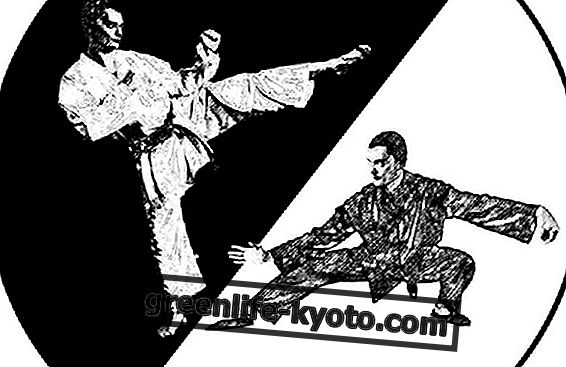
Enrico Petrella has a calm attitude towards life and you immediately realize it. Smiling, too. Ideally, these characteristics should belong to the teachers of psychophysical practices, if only because they can transmit integrity to the students. But this is not always the case. Often the teacher is centered on himself, to the point of moving away from the essence.
Enrico is a yoga teacher and author of "Verso lo yoga" (Mursia), "The well-being of the spine" (Aquarian Age). He started from the stars and landed at the asanas . The asanas - he explained to me, it would be more correct to write - because the term is considered to be of male gender by Sanskrit-speaking scholars, and the final one for the plural is due to the influence of the English language, thanks to which these practices have been known in the West .
How did you start yoga?
I started at 20, with what we could call Raja Yoga ; in that period I started with astrology as an instrument of inner research then yoga served to bring this research also on the physical side, on the plane of the body. The practice also gave a balance to the mental component of astrology.
Why did you write a specific text on your spine?
It was a choice shared with the publishing house, Lindau (Age of the Aquarius). The editorial choice fell on manuals with a specific theme and therefore it was thought that the vertebral column was a topic of fairly general interest. Even those who do not practice yoga, in fact, find themselves wanting to learn about exercises that can be useful for managing diseases such as back pain.
The end result is a very practical manual, which allows you to do exercises even for those who are self-taught, being very simple to perform (they can be done at home). However, to those who want to learn more I always suggest getting guided; it pays to rely on a teacher. The manual can be a way of starting the practice independently.
When did you become a yoga teacher?
I did a training course and I graduated in 2000. I then taught continuously for about 5 or 6 years. Among the students I had people of the most varied age groups; I taught a specific yoga for teenagers, also teenagers with disabilities (mental and physical disabilities).
A really important experience was the drug for addicts I did in the form of volunteering. In many contexts I also found myself managing classes with a massive presence of older people and it was important.
How do you work on addiction to yoga?
Look, I worked in a reception center together with people who had just come out of full dependency or were still inside but with the will to get out. I did what I could ... you know, you're dealing with a practically constant lack of attention. Moreover, in the face of such different cases, it is difficult to make a unitary collective speech.
Take the case of the heroin addict : basically his tendency is to fall asleep. The cocaine addict is completely different, the energy of which is not easily manageable or containable. It was impossible to make a plan, it was necessary to be very present. You could not develop a uniform speech, the real benefit was being able to get them to stay in their body for a consecutive hour.
Did you have particular precautions towards them at the level of the practice?
Yes, for example, I paid particular attention to the positions that call into question the liver, such as bending.
Have you also worked with other "difficult categories"?
Yes, with people with both motor and mental disabilities, they were mixed classes. In this context, psychotherapy is based on body practice. Also in this case the advantages of the group benefited but also the disadvantages, the individual specificity was lost a little.
How could you overcome this difficulty that is common to many yoga teachers?
In this I came back very useful the path that I did, which has a rather inner quality . At that point, when your gaze is turned inwards and that's how you learned yoga, you end up giving less emphasis to the kind of techniques; it becomes important how the person lives them. Even if I assign common exercises, I always suggest to manage them personally.
Have you ever thought of combining your knowledge of stars with yoga, structuring practices that fit well on the person based on the sign and the ascendant, for example?
Many aspects of the person are identified through the astral theme . I had the opportunity to experience it at the Casale in Lunigiana, where we organized yoga sessions and, together, I gave the audience the map of the sky. It was very interesting and it is something that is an integral part of my initial experience.
Do you ever take lessons based on astral transits?
We are always stimulated by transits, if there is any dynamizing influence, it may happen that it is natural to energize the exercises, but I have never consciously put together the two aspects by planning based on transits.
You have translated "Rediscovered wisdom. Philosophy as therapy." (Mursia), text by Mónica Cavallé. You explained to me that the translation process was a spontaneous, natural flow. Can you tell us in what sense philosophy can be therapy according to the author?
There was an immediate resonance with this text in me.
The psychological knowledge I have derives from astrology and has merged into yoga, along with a deepening of Western psychological theories. Our philosophical tradition has been dried up by some choices that have brought philosophy to something sclerotic, which is why it is a matter of taking up the underlying meaning.
The fundamental step that the author faces is the connection with oneself. It is not a question of adhering to a philosophical apparatus or a religious system blindly, the point is not to take them as entities detached from themselves. Knowledge is what you recognize as part of yourself ; when this passage takes place, that sense of abstract, sterile also falls.
While I was translating this book I was not teaching, but it helped me a lot; I have not found new things at all, they were subjects that already lived in me, but when a skilful writer knows how to sew them together in a deep and intelligent way it is certainly useful. And it went like this: I read and translated, exactly, a flow.
Why do we talk about wisdom?
The hook that is missing, as I said, is the one with you. And therefore a return to the origins is proposed. The term that the author uses is wisdom, not philosophy, and perennial wisdom is that which we have rediscovered by searching for example in Eastern spirituality or in shamanism that survived among Native Americans, Africans, Australians ...
Our tradition has become esoteric, because it has been hidden. In reality if we look more closely behind Christianity we find persecuted Gnosticism, behind Islam, Sufism, Taoism in the case of Confucianism. These traditions have been hidden. Take also Siberian shamanism ; in Russia, atheist communism sought to erase Siberian shamanism.
Tell me, with your wisdom, what do you think there is a need right now, in micro and macrocosmic terms?
To unleash your potential : the talents, emerging from certain stifling patterns and which, among other things, are breaking on their own. It takes a little courage, a little push to be able to go beyond. The teaching that can be drawn from yoga is to see the limit and be in the limit ; when you have known it in the silence of your interiority, it falls, but first it is necessary to see it.
You don't have to force yourself.
In practice it is the same, if the body suggests to stop, the mind obeys the competition, one goes to a place where the practice becomes painful, uncomfortable. Observing and listening, this is the key to transformation . We stop, we feel the tension, we taste it with our breath and we come back later. Out of mind control, the body melts on its own.
Are you currently teaching?
No, I wanted to take some time to avoid tying the practice to money. My interest now concerns Pranayama (the discipline of breathing) and on Yoga Nidra (conscious sleep), that is, the practice that develops from guided relaxation.
READ ALSO
Yoga as a disposable workout
Yoga practice for everyone
Muscles and breathing













